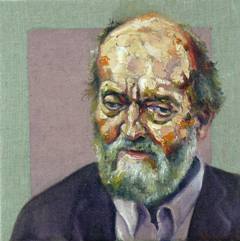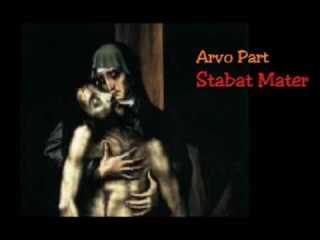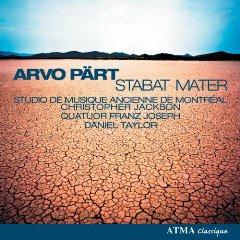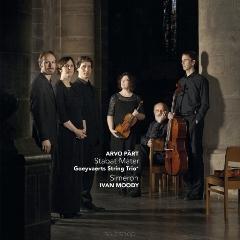Stabat Mater by Arvo Pärt
| Classical Notes |
Stabat Mater by Arvo Pärt
When Arvo Pärt sets words to music, he gives the impression of having entered into the depths of his chosen text and returned to the surface with an entirely fresh impression of what it's all about. This is certainly true of his “Stabat Mater,” and yet the result is to reaffirm the traditional significance of the text and to place the work securely in the long line of settings that includes those of Josquin Desprez, Lassus, and Palestrina, and in modern times Poulenc and Penderecki. Pärt achieves this partly by the purity and simplicity of his musical language, and partly by the way in which he draws such powerfully expressive music directly out of the rhythms and forms of the text, so that it almost seems as if the words have composed the music.
Stabat Mater by Arvo Pärt
Arvo Pärt was born in Estonia in 1935. Most of the works at the beginning of his career were for piano in the neo-classical style. After that, he turned his interest to serial music and continued creating works with serial techniques throughout the 1960s. After his “self-imposed silence” period (during the years 1968-1976), Pärt emerged with a new musical style, which he called “tintinnabuli.” Although, this technique was influenced by music from the medieval period, the texture and function of its musical style cannot be described easily in terms of any single musical technique of the past.

Arvo Pärt
Tintinnabuli comes from the latin word ‘tintinnabulum’ which translates to ‘bell’ (you may recognize the word from Edgar Allen Poe’s poem “The Bells,” in which he coined the word “tintinnabulation”). When a bell is struck, we hear an initial single tone but then we also begin to hear the overtones emanating from the initial tone. “The tintinnabuli method,” writer Arthur Lubow explains in a 2010 article for The New York Time Magazine, “pairs each note of the melody with a note that comes from a harmonizing chord, so they ring together with bell-like resonance.” Specifically, Pärt is concerned with triads and diatonic melodies, heavily influenced by the sound of Gregorian chant and the Notre Dame School (which refers to a group of composers working between the mid 12th and 13th centuries). To our contemporary ears, it is a relatively simple music, evocative (as you would imagine) of dark, incense-filled abbeys.

Arvo Pärt - Stabat Mater
“Stabat Mater” was composed in 1985 when Pärt got a commission by the Alban Berg Foundation. The title is a similar name to the medieval sequence that was attributed to Jacopone da Todi (c. 1230-1306), a Franciscan monk. There are two hymns in Stabat Mater, which are ‘Stabat Mater Dolorosa’ and ‘Stabat Mater Speciosa.’ Stabat Mater Dolorosa, which means “sorrowfully his mother stood” in Latin, reflects Mary’s suffering during Jesus Christ’s crucifixion. Wright suggests that Pärt’s version of Stabat Mater text is very similar to the version of Palestrina. This is probably because Pärt may have known the Palestrina’s setting when he studied pre-Baroque music during the 1970s.

Arvo Pärt - Stabat Mater (Quator Franz Joseph)
A pathetic motif of three descending notes is elaborated instrumentally and vocally. The text is sung in a slow recitative and the sparse, open texture of the vocal lines is paralleled by the string parts, heightening the pain and anxiety of the text. The predominant slow motion is interrupted three times by short fast gigs. In the "Amen" at the end the motif from the beginning returns. The Stabat Mater is, in many ways, a realization of the composer’s goal to find “a musical line that is a carrier of the soul, an absolute monody, a naked voice from which everything originates.”

Stabat Mater
This work differs from Pärt’s other music that uses sacred texts because other works are set up for choir; however, Stabat Mater was composed for string trio and solo voices (soprano, contratenor (alto), and tenor). This instrumentation suggests a similar sound to chamber music. It has a duration of approximately 24 minutes. A version with expanded forces (mixed chorus and orchestra) was premiered on 12 June 2008 at the Großer Musikvereinssaal during the Wiener Festwochen 2008 with Kristjan Järvi conducting the Singverein der Gesellschaft der Musikfreunde in Wien and the Tonkünstler-Orchester Niederösterreich. This new version was commissioned by the Tonkünstler-Orchester.

Arvo Pärt - Stabat Mater (Goeyvaerts String Trio)
Stabat Mater could be described as Pärt’s greatest hit. The orchestra and choir work together in this commemoration of the Virgin Mary’s suffering on witnessing the death of her son. The low mournful sound of the music is abruptly joined by a high keening vocal lament. In the end, one doesn't hear the music as part of the tintinnabuli method or as the product of a system of composition, but rather as lovely, simple music whose magnetic appeal is undeniable.

Stabat Mater
Arvo Pärt - Stabat Mater: Part I
Last Updated (Tuesday, 30 October 2018 00:23)








